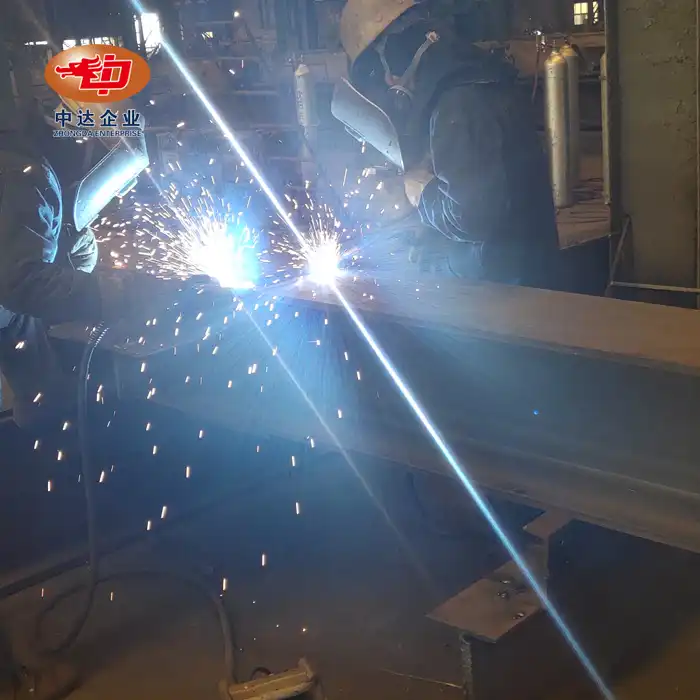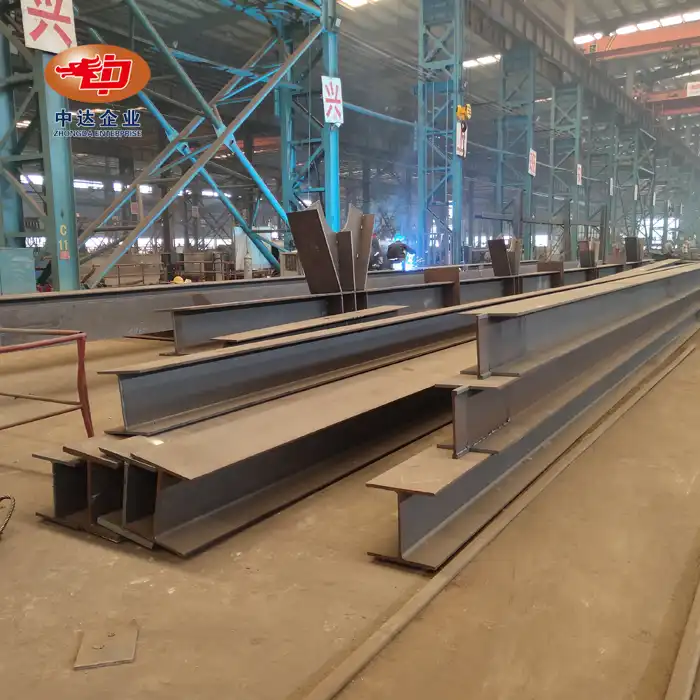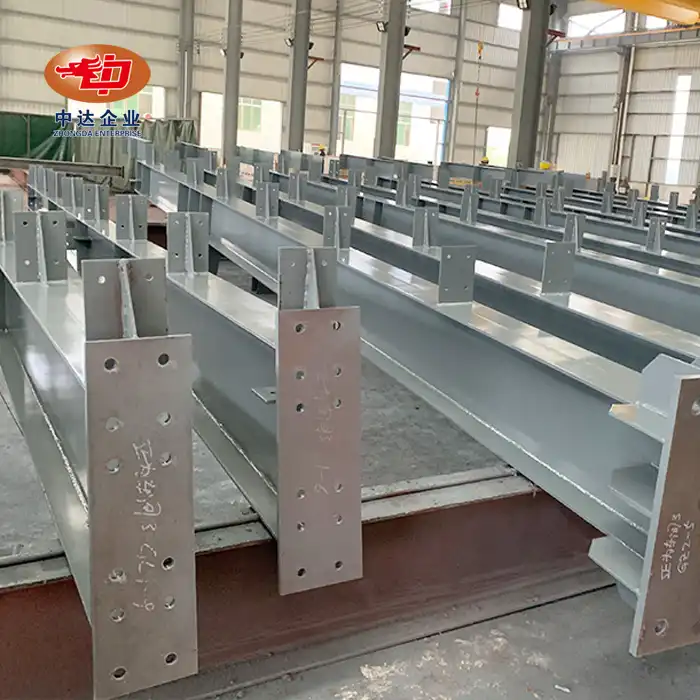Material Standards and Specifications
Steel Grade Requirements
The foundation of any robust steel truss beam lies in the quality of its materials. Building codes typically mandate the use of high-strength steel for truss beams, particularly for long-span applications. At Zhongda Steel, we utilize Q420D high-strength steel for our long-span steel truss beams, which spans an impressive 20-80 meters. This grade of steel offers superior strength-to-weight ratios, allowing for lighter yet more durable structures.
Building codes often specify minimum yield strength requirements for steel used in truss beams. For instance, ASTM A992 steel, with a minimum yield strength of 50 ksi (345 MPa), is commonly prescribed for structural steel shapes in many jurisdictions. It's crucial to verify the specific steel grade requirements in your local building codes, as they may vary depending on the project's location and intended use.
Welding Certifications
Welding plays a critical role in the structural integrity of steel truss beams. Building codes typically require welding procedures and personnel to be certified according to recognized standards. At Zhongda Steel, we adhere to ISO 3834 welding certification, ensuring our welding processes meet international quality standards. This certification is often recognized by building codes worldwide, providing assurance of weld quality and consistency.
Additionally, many building codes reference AWS D1.1 Structural Welding Code - Steel, which provides comprehensive guidelines for welding structural steel. Familiarize yourself with the specific welding requirements in your local building codes, as they may dictate inspection frequencies, testing procedures, and documentation requirements for welded connections in steel truss beams.
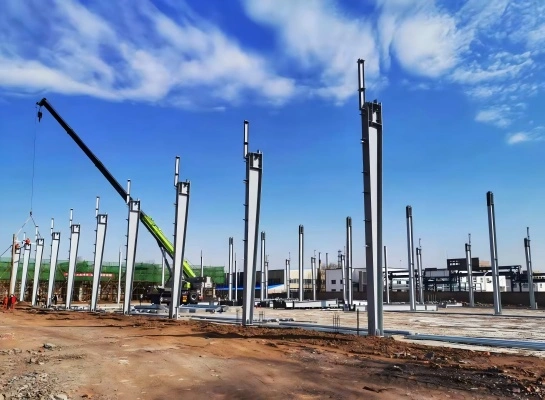
Corrosion Protection
Building codes often mandate corrosion protection measures for steel truss beams, especially in environments prone to moisture or chemical exposure. Common requirements include hot-dip galvanization, protective coatings, or the use of weathering steel. At Zhongda Steel, we offer advanced anti-corrosion technologies, including our proprietary -60°C Weathering Steel Anti-corrosion Technology, which provides exceptional durability in harsh environments.
Consult your local building codes for specific corrosion protection requirements, as they may vary based on the building's location, intended use, and exposure conditions. Some codes may also specify minimum coating thicknesses or performance criteria for protective systems.
Design and Load Considerations
Load Calculations and Factors
Accurate load calculations are paramount in designing safe and efficient steel truss beams. Building codes provide specific guidelines for determining design loads, including dead loads, live loads, wind loads, and seismic loads. These codes often reference standards such as ASCE 7 for load determination methodologies.
At Zhongda Steel, we employ advanced Finite Element Analysis (FEA) to optimize stress distribution in our long-span steel truss beams, resulting in a 25% increase in load-bearing capacity compared to conventional designs. This approach allows us to meet and exceed building code requirements for load resistance while maintaining efficient material usage.
Pay close attention to load combination requirements specified in building codes, as they often mandate the consideration of multiple load scenarios to ensure structural resilience under various conditions. Factor of safety requirements for different load types and combinations should also be carefully applied in your design calculations.
Deflection Limits
Building codes typically impose strict deflection limits on steel truss beams to ensure serviceability and prevent damage to connected building elements. These limits are often expressed as fractions of the span length and may vary depending on the building's occupancy type and the specific structural element.
For example, a common deflection limit for roof trusses supporting plaster ceilings might be L/360 (where L is the span length) under live loads. However, more stringent limits may apply for floor trusses or in buildings with sensitive equipment. Be sure to consult your local building codes for the applicable deflection criteria in your project.
Connections and Fasteners
The design and execution of connections in steel truss beams are critical aspects governed by building codes. At Zhongda Steel, our bolt connection nodes comply with AISC standards, ensuring robust and reliable joints. Building codes often specify minimum bolt sizes, edge distances, and spacing requirements for bolted connections.
For welded connections, codes may mandate specific electrode types, weld sizes, and inspection procedures. Pay particular attention to requirements for moment-resisting connections, as these are crucial for the overall stability of the structure. Some codes may also require the use of slip-critical connections in certain applications to enhance structural performance under dynamic loads.
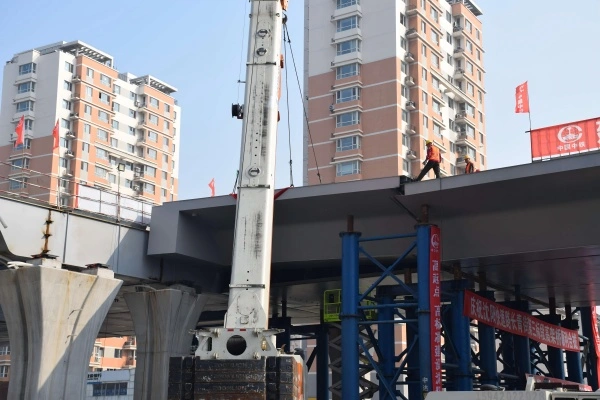
Fabrication and Installation Requirements
Quality Control Measures
Building codes often mandate comprehensive quality control measures throughout the fabrication process of steel truss beams. These requirements typically include material traceability, dimensional tolerances, and non-destructive testing procedures. At Zhongda Steel, our ISO 9001-certified processes ensure rigorous quality control at every stage of production, from material selection to final inspection.
Familiarize yourself with the specific quality control requirements in your local building codes, as they may dictate minimum inspection frequencies, testing methods, and documentation procedures. Some codes may also require third-party inspections or certifications for critical structural elements.
Erection and Assembly Guidelines
Proper erection and assembly of steel truss beams are crucial for ensuring structural integrity and safety. Building codes often provide detailed guidelines for the handling, storage, and installation of structural steel elements. At Zhongda Steel, we provide comprehensive 3D diagrams and BIM models to facilitate smooth assembly and installation of our long-span steel truss beams.
Pay close attention to requirements for temporary bracing, alignment tolerances, and connection procedures during erection. Some building codes may also specify minimum qualifications for erection personnel or mandate the presence of a qualified supervisor during critical installation phases.
Fire Protection Requirements
Fire resistance is a critical consideration in building codes for steel truss beams, especially in multi-story or high-occupancy structures. Codes typically specify minimum fire resistance ratings for structural elements based on the building's occupancy type and height. These ratings are often expressed in hours of fire resistance and may be achieved through various methods, including intumescent coatings, spray-applied fire-resistive materials, or encasement in fire-resistant materials.
Consult your local building codes for specific fire protection requirements applicable to your project. Some codes may allow for performance-based design approaches, which can offer more flexibility in achieving the required fire resistance while optimizing material usage and architectural considerations.
Conclusion
Navigating the intricate landscape of steel truss beam building code requirements is essential for ensuring the safety, durability, and compliance of your construction projects. By adhering to material standards, optimizing design calculations, and implementing rigorous quality control measures, you can harness the full potential of these versatile structural elements. Remember that building codes are dynamic and may vary by jurisdiction, so always consult the most up-to-date regulations applicable to your specific project location.
Contact Us
Ready to elevate your construction projects with state-of-the-art long-span steel truss beams? Trust Zhongda Steel to deliver unparalleled quality, innovative design, and comprehensive support for your structural needs. Contact us today at Ava@zd-steels.com to learn how our advanced steel solutions can bring your architectural visions to life while ensuring full compliance with building code requirements.
References
American Institute of Steel Construction. (2022). Specification for Structural Steel Buildings (ANSI/AISC 360-22).
International Code Council. (2021). International Building Code (IBC).
American Society of Civil Engineers. (2016). Minimum Design Loads and Associated Criteria for Buildings and Other Structures (ASCE/SEI 7-16).
American Welding Society. (2020). Structural Welding Code - Steel (AWS D1.1/D1.1M:2020).
European Committee for Standardization. (2005). Eurocode 3: Design of steel structures - Part 1-1: General rules and rules for buildings (EN 1993-1-1).
National Fire Protection Association. (2021). Standard for Fire Protection of Steel Construction (NFPA 263).











